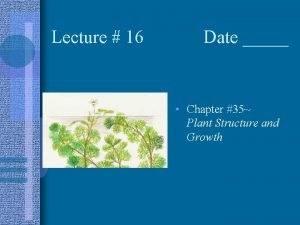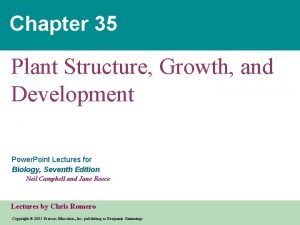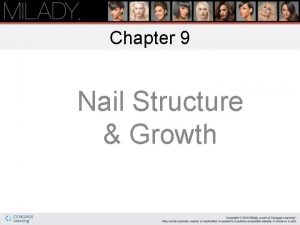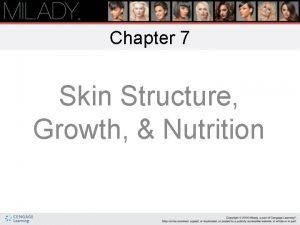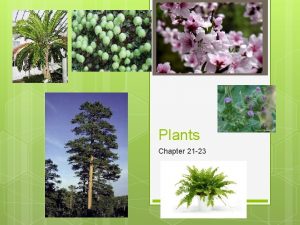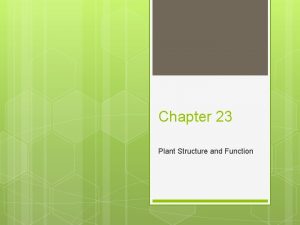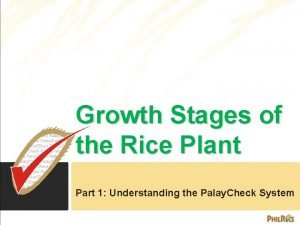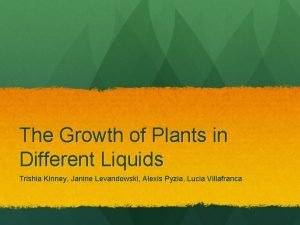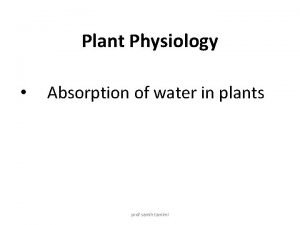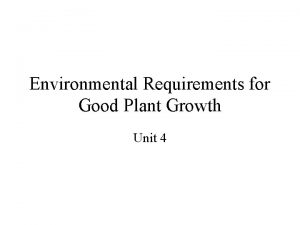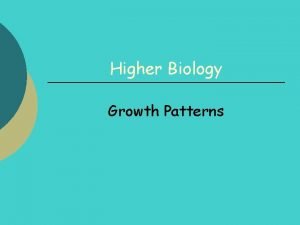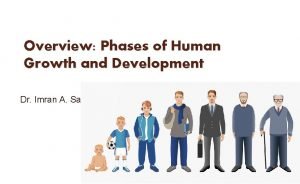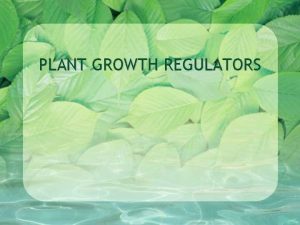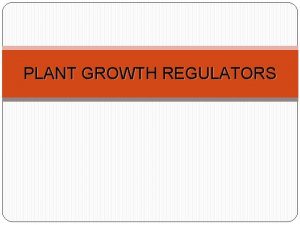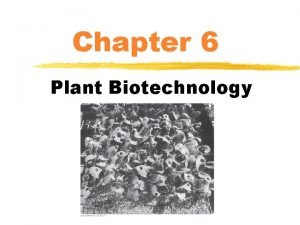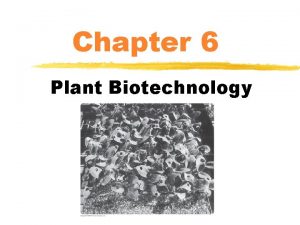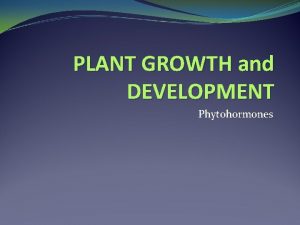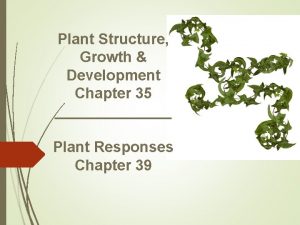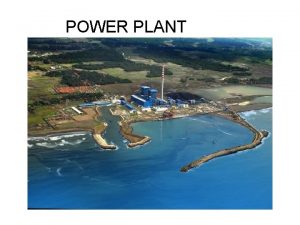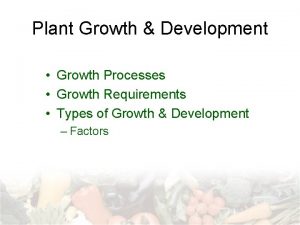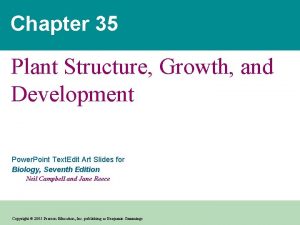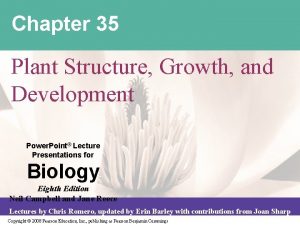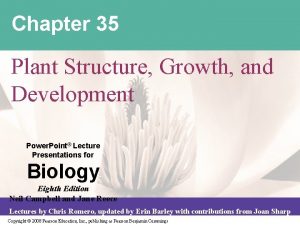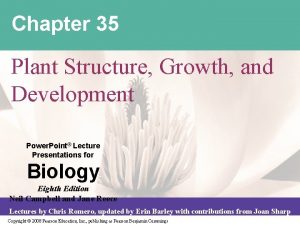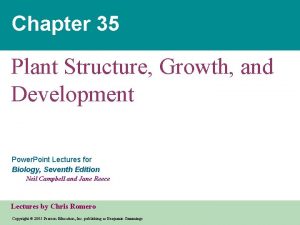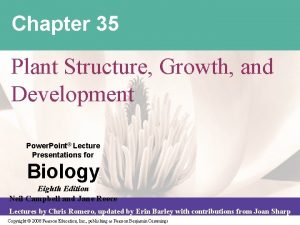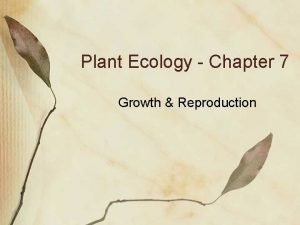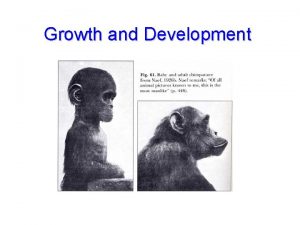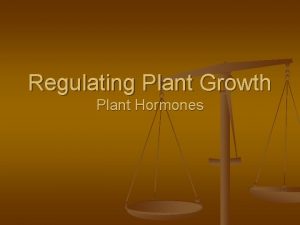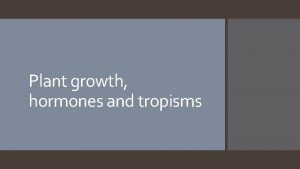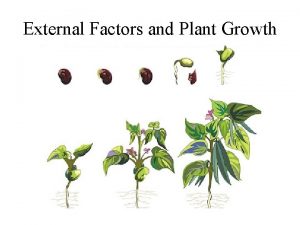Chapter 35 Plant Structure Growth and Development Power











































- Slides: 43

Chapter 35 Plant Structure, Growth, and Development Power. Point Lectures for Biology, Seventh Edition Neil Campbell and Jane Reece Lectures by Chris Romero Copyright © 2005 Pearson Education, Inc. publishing as Benjamin Cummings

Copyright © 2005 Pearson Education, Inc. publishing as Benjamin Cummings

The Three Basic Plant Organs: Roots, Stems, and Leaves • Basic morphology of vascular plants reflects their evolution as organisms that draw nutrients from below-ground above-ground Copyright © 2005 Pearson Education, Inc. publishing as Benjamin Cummings

• Three basic organs evolved: roots, stems, and leaves • They are organized into a root system and a Reproductive shoot (flower) Terminal bud shoot system Node Internode Terminal bud Vegetable shoot Blade Leaf Petiole Axillary bud Stem Shoot system Taproot Lateral roots Copyright © 2005 Pearson Education, Inc. publishing as Benjamin Cummings Root system

Roots • Functions of roots: – Anchoring the plant – Absorbing minerals and water – Often storing organic nutrients Copyright © 2005 Pearson Education, Inc. publishing as Benjamin Cummings

LE 35 -4 a Prop roots.

LE 35 -4 b Storage roots.

LE 35 -4 c “Strangling” aerial roots.

LE 35 -4 d Buttress roots.

LE 35 -4 e Pneumatophores.

Stems • A stem is an organ consisting of – An alternating system of nodes, the points at which leaves are attached – Internodes, the stem segments between nodes Copyright © 2005 Pearson Education, Inc. publishing as Benjamin Cummings

• An axillary bud is a structure that has the potential to form a lateral shoot, or branch • A terminal bud is located near the shoot tip and causes elongation of a young shoot Copyright © 2005 Pearson Education, Inc. publishing as Benjamin Cummings

LE 35 -5 a Stolons.

LE 35 -5 b Storage leaves Stem Roots Bulbs.

LE 35 -5 c Tubers.

LE 35 -5 d Rhizomes. Node Rhizome Root

Leaves • The leaf is the main photosynthetic organ of most vascular plants • Leaves generally consist of – A flattened blade and a stalk – The petiole, which joins the leaf to a node of the stem Copyright © 2005 Pearson Education, Inc. publishing as Benjamin Cummings

• Monocots and eudicots differ in the arrangement of veins, the vascular tissue of leaves • Most monocots have parallel veins • Most eudicots have branching veins Copyright © 2005 Pearson Education, Inc. publishing as Benjamin Cummings

LE 35 -6 a Simple leaf Petiole Axillary bud

LE 35 -6 b Leaflet Compound leaf Petiole Axillary bud

LE 35 -6 c Doubly compound leaf Leaflet Petiole Axillary bud

• Some plant species have evolved modified leaves that serve various functions Copyright © 2005 Pearson Education, Inc. publishing as Benjamin Cummings

LE 35 -7 a Tendrils.

LE 35 -7 b Spines.

LE 35 -7 c Storage leaves.

LE 35 -7 d Bracts.

LE 35 -7 e Reproductive leaves.

The Three Tissue Systems: Dermal, Vascular, and Ground • Each plant organ has dermal, vascular, and ground tissues Dermal tissue Ground tissue Copyright © 2005 Pearson Education, Inc. publishing as Benjamin Cummings Vascular tissue

• In nonwoody plants, the dermal tissue system consists of the epidermis • In woody plants, protective tissues called periderm replace the epidermis in older regions of stems and roots Copyright © 2005 Pearson Education, Inc. publishing as Benjamin Cummings

• The vascular tissue system carries out longdistance transport of materials between roots and shoots • The two vascular tissues are xylem and phloem • Xylem conveys water and dissolved minerals upward from roots into the shoots • Phloem transports organic nutrients from where they are made to where they are needed Copyright © 2005 Pearson Education, Inc. publishing as Benjamin Cummings

• The vascular tissue of a stem or root is collectively called the stele • In angiosperms • Roots: • Stems and leaves divided into vascular bundles: Copyright © 2005 Pearson Education, Inc. publishing as Benjamin Cummings

• Ground tissue includes cells specialized for storage, photosynthesis, and support Copyright © 2005 Pearson Education, Inc. publishing as Benjamin Cummings

• Some major types of plant cells: – Parenchyma – Collenchyma – Sclerenchyma – Water-conducting cells of the xylem – Sugar-conducting cells of the phloem Copyright © 2005 Pearson Education, Inc. publishing as Benjamin Cummings

LE 35 -9 WATER-CONDUCTING CELLS OF THE XYLEM PARENCHYMA CELLS Vessel Parenchyma cells in Elodea leaf, with chloroplasts (LM) Tracheids 100 µm 60 µm Pits COLLENCHYMA CELLS 80 µm Cortical parenchyma cells Tracheids and vessels (colorized SEM) Vessel elements with perforated end walls Tracheids SUGAR-CONDUCTING CELLS OF THE PHLOEM Collenchyma cells (in cortex of Sambucus, elderberry; cell walls stained red) (LM) SCLERENCHYMA CELLS Sieve-tube members: longitudinal view (LM) 5 µm Companion cell Sclereid cells in pear (LM) Sieve-tube member Plasmodesma 25 µm Sieve plate Cell wall Nucleus Cytoplasm Companion cell Fiber cells (transverse section from ash tree) (LM) 30 µm 15 µm Sieve-tube members: longitudinal view Sieve plate with pores (LM)

Concept 35. 2: Meristems generate cells for new organs • Apical meristems are located at the tips of roots and in the buds of shoots • Apical meristems elongate shoots and roots, a process called primary growth Copyright © 2005 Pearson Education, Inc. publishing as Benjamin Cummings

• Lateral meristems add thickness to woody plants, a process called secondary growth • There are two lateral meristems: the vascular cambium and the cork cambium • The vascular cambium adds layers of vascular tissue called secondary xylem (wood) and secondary phloem • The cork cambium replaces the epidermis with periderm, which is thicker and tougher Copyright © 2005 Pearson Education, Inc. publishing as Benjamin Cummings

LE 35 -10 Primary growth in stems Shoot apical meristems (in buds) Epidermis Cortex Primary phloem Primary xylem Vascular cambium Lateral meristems Cork cambium Pith Secondary growth in stems Periderm Cork cambium Pith Cortex Primary phloem Primary xylem Root apical meristems Secondary xylem Secondary phloem Vascular cambium

LE 35 -11 Terminal bud Bud scale Axillary buds Leaf scar This year’s growth (one year old) Node Stem Internode One-year-old side branch formed from axillary bud near shoot apex Leaf scar Last year’s growth (two years old) Scars left by terminal bud scales of previous winters Growth of two years ago (three years old) Leaf scar

Concept 35. 3: Primary growth lengthens roots and shoots • Primary growth produces the primary plant body, the parts of the root and shoot systems produced by apical meristems Copyright © 2005 Pearson Education, Inc. publishing as Benjamin Cummings

Primary Growth of Roots • The root tip is covered by a root cap, which protects the apical meristem as the root pushes through soil • Growth occurs just behind the root tip, in three zones of cells: – Zone of cell division – Zone of elongation – Zone of maturation Video: Root Growth in a Radish Seed (time lapse) Copyright © 2005 Pearson Education, Inc. publishing as Benjamin Cummings

LE 35 -12 Cortex Vascular cylinder Epidermis Key Root hair Dermal Zone of maturation Ground Vascular Zone of elongation Apical meristem Root cap 100 µm Zone of cell division

• The primary growth of roots produces the epidermis, ground tissue, and vascular tissue • In most roots, the stele is a vascular cylinder • The ground tissue fills the cortex, the region between the vascular cylinder and epidermis • The innermost layer of the cortex is called the endodermis Copyright © 2005 Pearson Education, Inc. publishing as Benjamin Cummings

LE 35 -13 Epidermis Cortex Vascular cylinder Endodermis Pericycle Core of parenchyma cells Xylem 100 µm Phloem 100 µm Transverse section of a typical root. In the roots of typical gymnosperms and eudicots, as well as some monocots, the stele is a vascular cylinder consisting of a lobed core of xylem with phloem between the lobes. Endodermis Pericycle Transverse section of a root with parenchyma in the center. The stele of many monocot roots is a vascular cylinder with a core of parenchyma surrounded by a ring of alternating xylem and phloem. Key Dermal Ground Vascular Xylem Phloem 50 µm
 Chapter 35 plant structure growth and development
Chapter 35 plant structure growth and development Chapter 35 plant structure growth and development
Chapter 35 plant structure growth and development Microtubules in plant cells
Microtubules in plant cells Rice plant growth stages
Rice plant growth stages Cytokinin function
Cytokinin function Chapter 7 human growth and development
Chapter 7 human growth and development Draw the power triangle
Draw the power triangle Growth analysis definition
Growth analysis definition Root hair structure
Root hair structure Primary growth and secondary growth in plants
Primary growth and secondary growth in plants Nail structure and growth
Nail structure and growth Specialized ligaments attach the nail bed and
Specialized ligaments attach the nail bed and Chapter 7 skin structure growth and nutrition
Chapter 7 skin structure growth and nutrition The growth of presidential power chapter 14
The growth of presidential power chapter 14 Chapter 14 section 1 the growth of presidential power
Chapter 14 section 1 the growth of presidential power Chapter 22 plant structure and function answer key
Chapter 22 plant structure and function answer key Chapter 21 plant structure and function
Chapter 21 plant structure and function Section 23-4 leaves
Section 23-4 leaves Step growth polymerization vs chain growth
Step growth polymerization vs chain growth Geometric growth population
Geometric growth population Neoclassical growth theory vs. endogenous growth theory
Neoclassical growth theory vs. endogenous growth theory Organic vs inorganic growth
Organic vs inorganic growth Tronsmo plant pathology and plant diseases download
Tronsmo plant pathology and plant diseases download Tronsmo plant pathology and plant diseases download
Tronsmo plant pathology and plant diseases download Albugo eye
Albugo eye Growth stages of rice plant
Growth stages of rice plant Plant growth with different liquids
Plant growth with different liquids Role of water in plant growth
Role of water in plant growth Role of transpiration
Role of transpiration Environmental requirements for good plant growth
Environmental requirements for good plant growth What is growth in biology
What is growth in biology Social changes in adulthood
Social changes in adulthood Theories about
Theories about Stages of human growth and development pictures
Stages of human growth and development pictures Social development in late childhood
Social development in late childhood Pretest: growth, development, and sexuality
Pretest: growth, development, and sexuality Maturation in growth and development
Maturation in growth and development Stage of growth and development
Stage of growth and development Emotional development is often stormy and in conflict
Emotional development is often stormy and in conflict Prof. meier and baldwin
Prof. meier and baldwin Personal growth and professional development examples
Personal growth and professional development examples Growth and development pictures
Growth and development pictures Middle childhood growth and development
Middle childhood growth and development Distinguish between growth and development
Distinguish between growth and development
